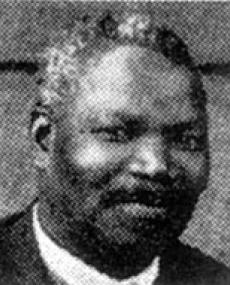
Little is known about Elias Moretsele's youth. At an early age he moved to Johannesburg where he joined the South African Native National Congress (SANNC, since 1923 the ANC) in 1917. He was the owner of an eating-house in the city, which in due course became a popular rendezvous for black politicians.
In 1933 he was a committee member of the then-Bapedi National Club in Johannesburg, a non-political club that was formed so that its members could help one another and provide social upliftment. This underscored Moretsele's commitment to and love for his tribe of origin, the Pedi of the North-Eastern Transvaal, which characterised his entire public career.
Moretsele's leadership role in the African National Congress (ANC) only began after the drastic reorganization of the Transvaal ANC in 1943 when he was elected to their working committee. He also became the provincial treasurer of the ANC in Transvaal, where he interpreted these events in different ways to the community during the black mineworkers' strike in August 1946 he was involved in liaison between the ANC and strike leaders.
At the annual congress of the Transvaal ANC at Sophiatown in October 1953 he was unanimously elected provincial president, after having been appointed a month previously as acting president by the Transvaal executive committee because Nelson Mandela, by virtue of the Suppression of Communism Act, had been one of those ordered to relinquish the office in question.
Shortly after Moretsele's election as ANC president of the Transvaal he became officially as well as personally involved in various quarrels. The first was a clash in the Newclare branch between supporters and opponents of the ANC's alliance with organisations of other races. The second was about his successful participation at Tie end of 1953 in the election of members of the Native Advisory Committee of the Western Native Town in Johannesburg where he became a candidate for the local 'Vigilance Committee' (also called the Blue Party). His involvement with that committee brought considerable criticism down upon his head. The third was the dispute between supporters and opponents of school boycotts as a weapon of resistance against the implementation of the Bantu Education Act in 1955.
Moretsele was a zealous supporter of school boycotts. However, after a large number of children were permanently suspended because they had gone ahead with boycotts, many parents and ANC leaders - to his dissatisfaction - directed a representation to the government to have the children readmitted. By 1955 Moretsele was also a member of the National Executive Committee of the ANC. In this capacity he was involved in arranging and attending meetings of the Congress of the People, where he officially welcomed all the delegates. Thereafter, he continually defended the Freedom Charter against the Africanists who rejected its multiracial basis. At the time, especially within the ANC in Johannesburg's western areas, there was bitter disagreement about the Freedom Charter.
On 25 February 1958, two days after a chaotic provincial conference of the Transvaal ANC, during which the executive could not satisfactorily counter charges against them, Moretsele resigned as president of the Transvaal ANC. He did not, however, withdraw from politics. Not only was he again elected as provincial treasurer of the Transvaal ANC later in 1958, but he regularly visited the unrest-afflicted areas of Sekhukhuneland to help keep the flame of rebelliousness against apartheid burning.
In 1956 Moretsele was one of the 156 accused who were tried during the famous treason trial. He was in fact one of the last 30 accused held until end of trial, but died early in March 1961, three weeks before the acquittal of all the accused.